Hutterites in Montana trace their heritage back to 16th-century Germany. Their religious roots define their lifestyle today in Montana – they speak German, they don’t own their homes, they live communally, they receive no salaries, and live in colonies isolated from cities and towns.
So how did they settle in Montana? What do they believe? How do they live?
In this article, we answer all of these questions and more about Montana Hutterites.
In this article:
- 10 facts about Montana Hutterites
- Books about Hutterite culture
- Who are the Hutterites of Montana?
- Where do Hutterites in Montana originate from?
- How do Montana Hutterites live?
- Clothing of Montana Hutterites
- Men’s roles in the life of Montana Hutterites
- Women’s roles in the life of Montana Huterrites
- What do Montana Hutterites do for a living?
- FAQ – Hutterites in Montana
10 facts about Montana Hutterites
Here are ten facts about Montana Hutterites:
- Eastern European origins. The Hutterite colonies in Montana originate from south Germany and the surrounding areas (Switzerland, Italy, etc.).
- 400 years of migration. Their heritage dates back 400+ years to the Anabaptists of the Radical Reformation in Europe in the 16th century. Over the following centuries, Hutterites immigrated multiple times to avoid persecution, eventually fleeing to the United States in 1874.
- Work as worth. Their sense of personal worth comes less from the freedom to play, which they do have, than it does from participating in community work.
- Self-sufficient. Hutterites work the land and service their own machinery.
- Pacifist. Hutterites are pacifists and do not join the military.
- Solidarity with non-Hutterites. Hutterites feel complete solidarity with their uncoveted neighbors – in emergencies, they have no problem working with the red cross or the military (though they conscientiously object to military service).
- Large economic impact. Montana’s Hutterites produce about 60 percent of the state’s pork, half of the eggs, and about 17 percent of the milk.
- Communal lifestyle. Hutterites don’t own their own homes nor do they receive a salary for their daily work. Homes and other physical possessions are owned communally and they work for the good of the community.
- Hierarchy and structure. Their internal governance system establishes the societal structure within the colony, with individual positions overseeing different areas of society.
- Hutterite German. They speak an Upper German dialect of Bavarian German on the colony, but most also speak English fluently.
If you want to dive deeper into Hutterite culture, beyond what we cover below, here are some top recommended books on Hutterite customs and culture:
The Hutterites of Montana are direct descendants of Anabaptists of the Radical Reformation of Europe in the 16th century. They live, according to the doctrine of their faith, in colonies in remote areas of Montana. They work the land, live communally, and remain mostly isolated from cities and towns, though they conduct agriculture business in the state.
Where do Hutterites in Montana originate from?
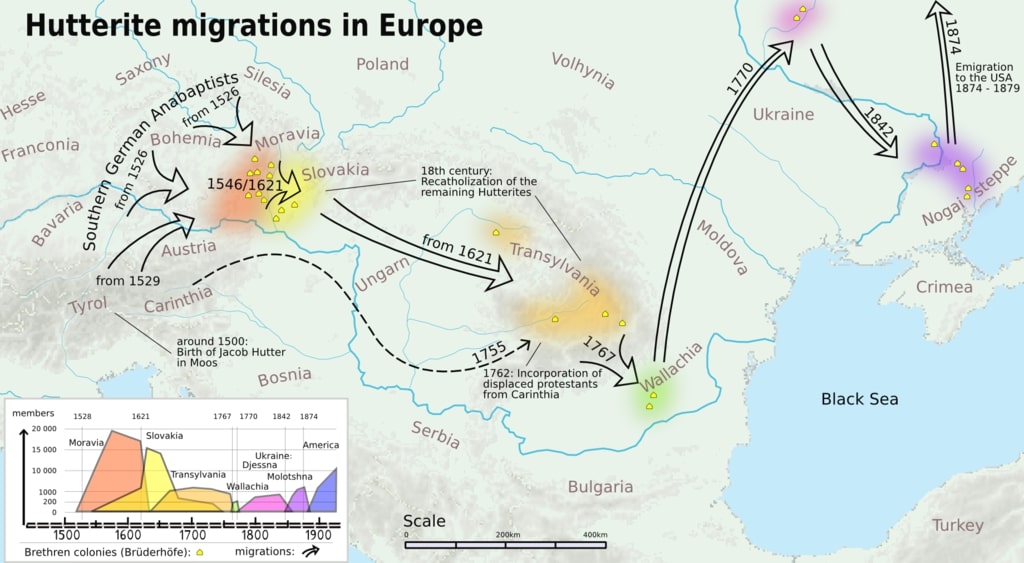
400 years ago in Europe, alleged corruption within the church brought about the Radical Reformation. From this, emerged many new Anabaptist religious groups, including the Hutterites, who desired radical change.
Facing prosecution, many of them fled. They immigrated from southern Germany to Moravia in the 1520s, to Transylvania (present-day Romania) in 1621, to Ukraine in 1770, and eventually to the United States in 1874. They have primarily resided in the U.S. and Canada ever since.
Montana vs Idaho – What’s the difference? Find out here.
How did they end up in Montana?
Prejudice against German-speaking farmers during World War I prompted them to flee the U.S. in 1918 for Canada.
Roughly a decade later, amid economic pressure on the farming sector during the Great Depression, some groups returned to the U.S. and settled in the northwestern agricultural states, such as Montana.
Today, Hutterite colonies in Montana live in relatively the same way they did 400 years ago, save for the modern technology they use for work, and they live in colonies in remote areas of the state.
How do Montana Hutterites live?
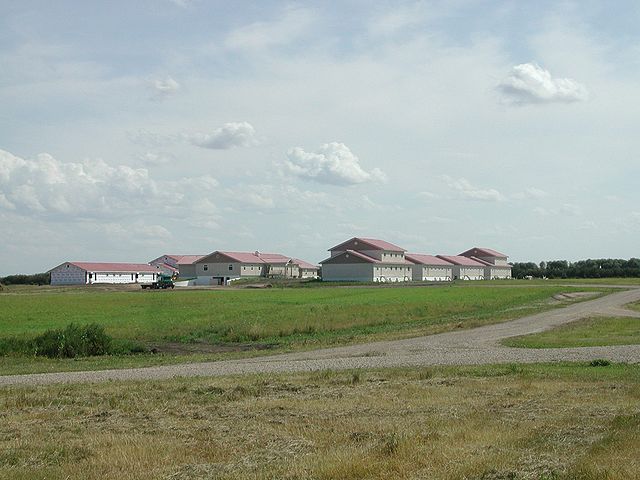
“That’s everybody’s piece of land as much as my own, so I feel I have to work it”
-Colony member, “Hutterites – To Care And Not To Care“
Montana Hutterites live in communities in remote regions of Montana. Their lives are founded on several fundamental principles – faith, work, and community.
They maintain a communal lifestyle, meaning there are no salaries and generally no personal property. Each person has a primary occupation but helps out as needed once their daily duties are finished. No one owns their home, and they eat meals together in the communal kitchens.
They attend church service every day of the week. The faith of Montana’s Hutterites commands balance, moderation, resisting temptation, and full devotion to faith, community, and family. Many aspects of their lives haven’t changed in 400 years.
What are the most dangerous animals in Montana? Find out here
Clothing of the Montana Hutterites
Hutterite colonies in Montana generally make their own clothing and shoes.
Men’s clothing
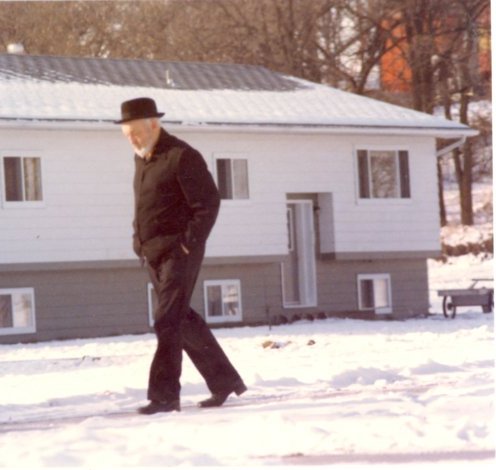
Men wear black pants, black jackets, and button-up shirts with long sleeves, usually with some colored pattern. Instead of belts, suspenders hold their pants up, which usually have no back pockets.
Women’s clothing
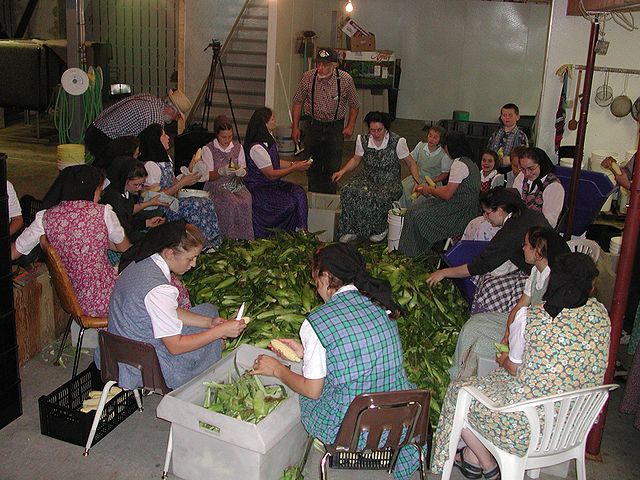
Girls wear dresses of various colors and patterns with a blouse underneath. Women in some colonies also wear a kerchief-style head covering, often black, blue, or white, and with or without white polka dots, depending on the colony.
Younger girls wear bright, colorful caps.
Church wear
Both men’s and women’s church wear is dark and plain, consisting of plain jackets for both and a black apron for women.
The role of Men in the Hutterite colonies in Montana
A normal day for men usually starts off with a coffee or meal in the communal kitchen, then tending to their official jobs as blacksmiths, broom makers, animal tenders, or another job. A Hutterite’s age also influences what kind of job they have.
When finished, the men chip in around the colony, helping out as needed feeding animals, repairing farm machinery, gathering eggs, and fulfilling other duties for the rest of the day.
The role of Women in the Hutterite colonies in Montana
Women generally don’t work in the fields. They often work in the communal kitchen, preparing food, such as orange bread, banana bread, and zucchini bread. They also prepare foods to sell at the farmers’ markets in nearby cities.
Women also help prepare daily meals for the colony.
What are the 10 largest ranches in Montana? Find out here
What do Montana Hutterites do for a living?
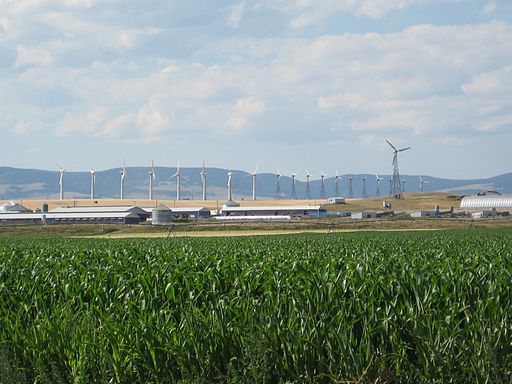
Montana’s Hutterites work the land, producing vegetables, meat, and dairy products.
They also reap the benefits of technological advances. They use the most modern equipment they can get for farming and raising animals and they make equipment that they need but can’t get.
The Hutterite colonies in Montana are known as reliable, hard-working people who sell high-quality agricultural products.
FAQ – Hutterites in Montana
Below are answers to frequently asked questions about Montana’s Hutterites.
How does their lifestyle differ from city life in Montana?
Hutterites live in colonies in remote regions of Montana, far from city life. They are communal and self-sufficient. They build their own homes and work the land.
Montana’s Hutterites are assigned homes within the community, use a central laundry facility, and prepare and eat meals in a communal kitchen. Everything within the community is shared and there are no salaries or wages.
The cohesiveness of their communities, hard work ethic, and low living costs due to the absence of salaries provides a sense of invaluable security to members. Life in the colony also offers a close bond with a large extended family.
What are some rules of Hutterite colonies?
The rules of the Hutterite colonies in Montana are based in religious beliefs and traditional customs.
Here are 10 rules that Montana Hutterites follow in daily life:
- Eat three meals together every day
- Work each day except Sunday
- Worship together daily in evening church services, plus a morning Sunday service
- Divorce is forbidden
- Adult baptism
- Some colonies limit internet use only to their agricultural technology, while others permit the use of the internet and other technologies more liberally
- Colony members can come and go as they wish
- Members can leave the colony and return without being shunned
- They are bilingual – they speak German in the colony and English with nonmembers
- They are pacifists and do not join militaries or fight wars
Can Hutterites leave the colony?
Yes, members of the colony can come and go as they wish. They can travel to other colonies, states, or countries, and can choose to leave the colony for good. If they rejoin the colony, they are not shunned.
What language do Hutterites speak?
Hutterites are bilingual. They speak an Upper German dialect of Bavarian German on the colony, but they also speak English and generally use English to communicate with nonmembers.
Where do the Hutterites live in Montana?
Hutterite colonies in Montana are located along the eastern front of the Rocky Mountains, in northern regions near the Canadian border and the Missouri Breaks, and in south-central Montana. There are about 5,000 Hutterites in Montana.
How many Hutterite colonies are in Montana?
There are about 50 Hutterite colonies in Montana, with roughly 100 people living in each colony.
Where else do Hutterites live, besides Montana?
Hutterites live in North America (WA, MT, ND, MN, OR, SD) and in Canada (BC, AB, SK, MB). There are about 490 colonies in total, consisting of three distinct groups – the Dariusleut, Schmiedeleut, and Lehrerleut. They share the same heritage and doctrine and only differ in dress, location, and leaders.
Are Hutterites like Amish?
Hutterites and Amish both trace their origins back to the Radical Reformation in Germany and Switzerland in the 16th century. Both are Anabaptist, ethnoreligious groups that live in intentional communities, separate from cities.
There are some differences between the two. Amish use traditional farming practices, while Hutterites use modern farming technology. Amish mostly reside across the north and northeastern regions of the U.S., while Hutterites mostly reside in the northwestern U.S. and in Canada.




